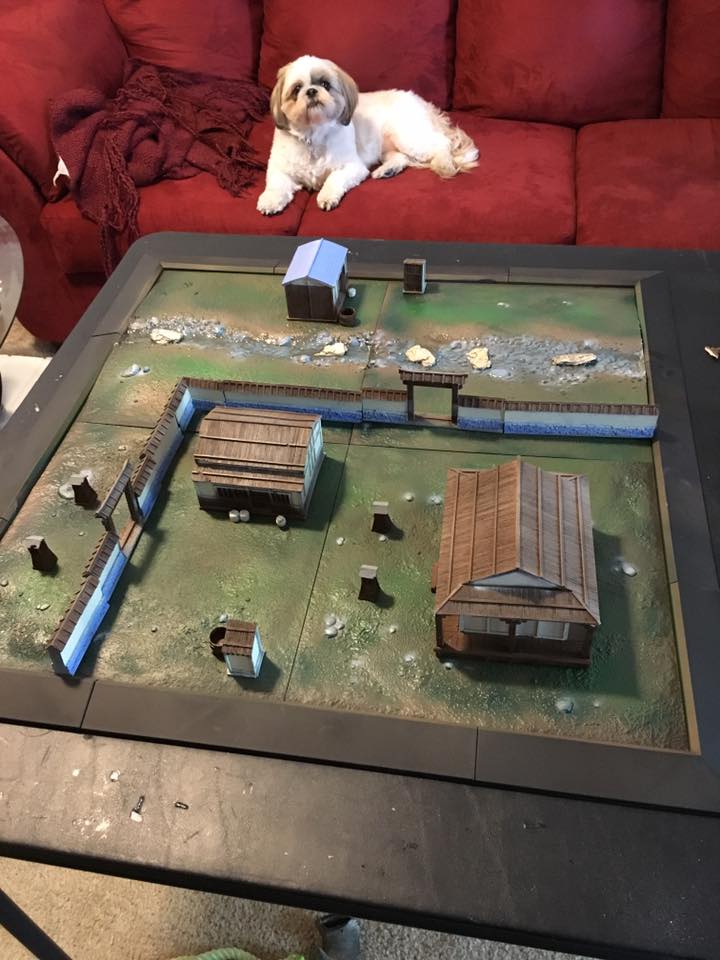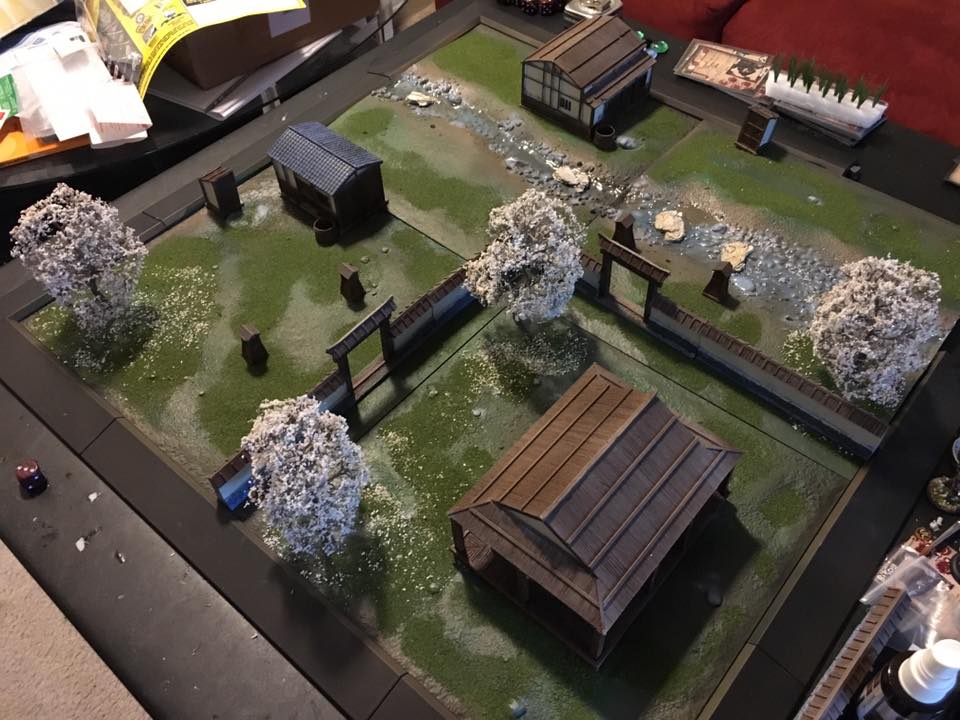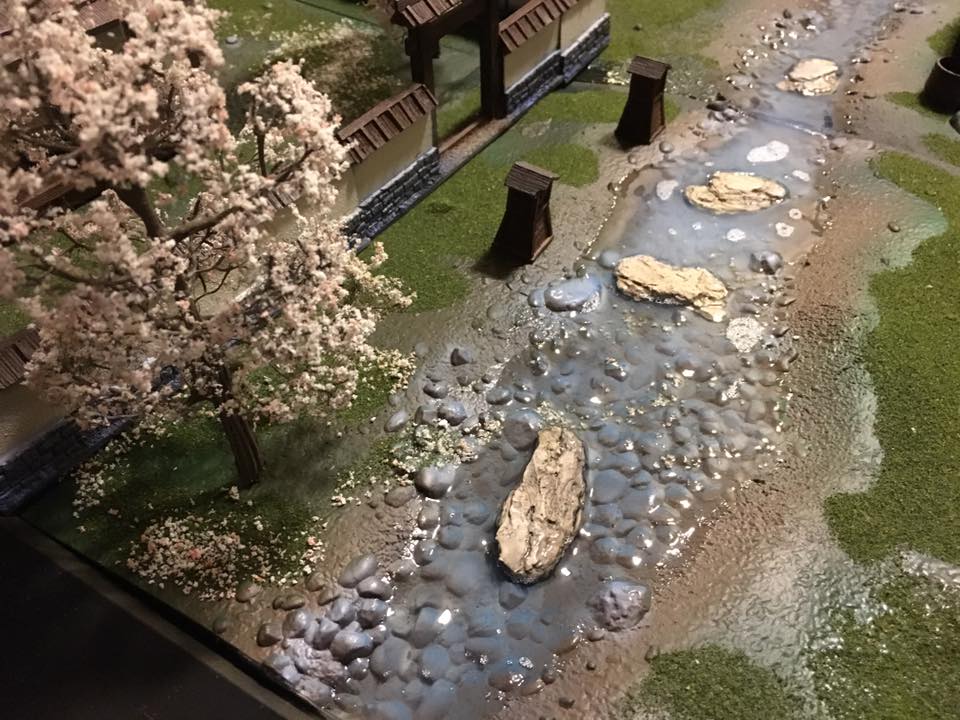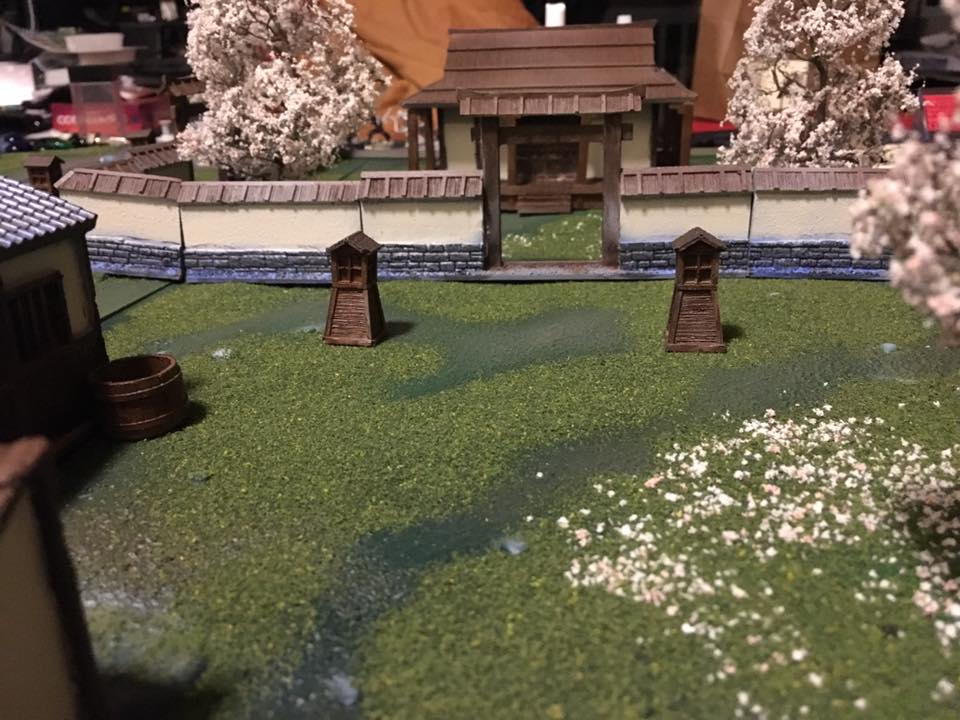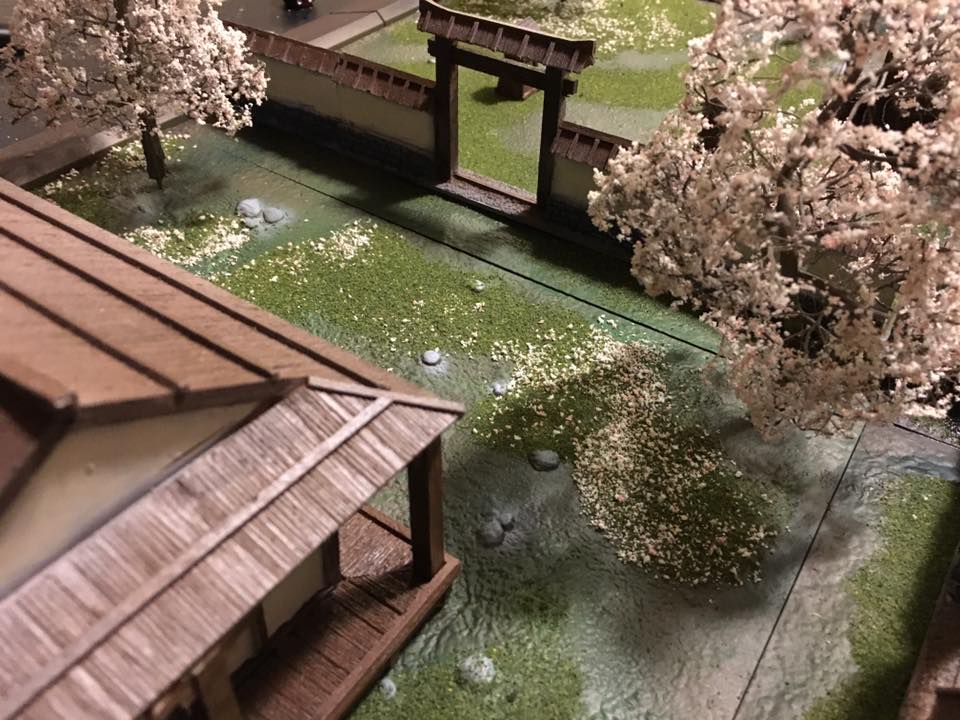So, it took a while to actually get all of the pieces I needed for this board. Specifically, I last posted about this board almost two months ago and it’s taken me this long to finally obtain everything. This weekend was a lot of painting and adaptation work, but I’m pretty happy with the end result:
You’ll notice a few things at a glance, first and foremost how my measurements were off. I’d originally planned a short piece, a long piece, and a gate on each side. The actual measurements of the pieces put a section of wall perilously close to (and for a short distance, inside) the stream. What looked like reasonable measurements on paper turned out not to fit in reality.
SO! Back to the drawing board as far as layout goes. I had a few games with friends over the weekend and played around with some board layouts. I knew I was going to need this iteration step anyway to get to a good place with the board, and since all of my original preplanning went kind of out the window, more thought was going to need to go into layout before I finalized anything.
The layout above, as it turns out, is a disaster. The whole map bottlenecks around a single gate, and players starting inside the walls have a huge advantage in most scenarios, while starting in opposite corners makes for a lot of really awkward positioning and very few compelling decision points.
Kodra helped me work out an alternate layout, suitable for at least trying:
It shortens the wall and opens up that quarter of the board a bit more. This is a shot taken after some more work has been done, so there are trees on the board, but you can see the rough similarities to my original design. One wall piece goes unused, but the space works a lot better.
In the first iteration, the larger building on the left was swapped with the small tiled-roof building in the bottom-center, but we quickly found that that made for a significant bottleneck problem between the wall and that building.
One major thing that came out of it over the course of three games was that different lists would approach the space differently, which is exactly what I want, and there were multiple ways to set up; both sets of opposite corners are interesting and compelling (also good). A big takeaway is that the side of the river opposite the main walled complex needed something to make it more defensible– it’s wide open with no cover, making it a fairly poor starting location and vulnerable to ranged attackers. It made movement on that side fairly predictable– deploy as far forward as possible, run to use the big wall as cover because you have no other options. It made an inordinate amount of play happen right around the wall corner, which isn’t bad (bottlenecks aren’t automatically awful), but would really cut into the replay value of the board.
Looking at the board from a different angle yields a better result, though we didn’t play on this layout.
A couple of physical takeaways on the board– while I’d hoped that the roof slats would make it reasonable to perch a model on the roof, it was more precarious than I would’ve liked. C’est la vie. More annoying was the smooth surface of the board tiles made for models sliding around pretty easily, which isn’t ideal. Luckily I’d picked up some grass flock and spray adhesive, and you can see patches of darker grass breaking up the simply painted board surface. This is more for traction than anything. I also noted that the stream was VERY shallow, and tended to make it awkward to put models in there. Making it deeper became a goal, just for more flat surface for mini placement.
I’m pretty happy with the layout above, but I also don’t think I’m in a place where I can call it permanent. This is a bit touchy, since I want to also place down foliage and there’s no good way to do that and still have the foliage move around. However, there are some predictable terrain needs that almost don’t care what the wall/building layout is:
1.) The riverbanks need cover; the stream area is too open in general.
2.) The opposite bank is way too open, and needs some kind of cover.
There’s virtually no building placement that changes these; the biggest thing is putting a building on the opposite bank which breaks up the space but doesn’t provide a lot of playable cover, just a dead space that blocks line of sight. I have a bunch of bamboo trees which work really nicely for terrain (because they’re essentially just sticks, meaning it’s easy to maneuver minis around them) which are going to pretty much all go into service of making the opposite riverbank a bamboo forest. In addition, I have a number of cat-tails to plant on the riverbanks, so the non-building side of the river will ultimately have a lot of usable cover, probably more than the building space itself.
I like this because my biggest issue has always been the building-side having a clear advantage. Now the river-side is really appealing as well, perhaps more so.
I’ve also placed four trees on the board. While these are static elements, I can still move and rotate the tiles and change up the board layout pretty easily even though the trees aren’t movable. For now, I don’t want to make any other elements static, because I’m still reworking the concept of static terrain.
One of my goals for building a static terrain board is that I can make it really look great and purposeful if I place everything in specific places. I’m finding that even without a static board, I can achieve surprisingly high quality visuals, even without significant pieces in place, like this:
This approach really needs a road to look “right”, but even without one, it looks acceptable. It’s not the highest possible fidelity, but I’m starting to look closely at the tradeoff I’d be making for that level of fidelity and wondering if it’s worth it. In carefully choosing certain low-impact static elements (the trees), I can still have a highly modular board without necessarily giving up appearance.
What I expect is that as I play more on the board, I’ll place more and more static terrain pieces, iterating on the design and determining which pieces move around a lot and which don’t. If I can, at any point, lock down a wall layout, I almost don’t need anything else to be static because I can simply put down roads and let the buildings sort themselves out. What I suspect, however, is that the walls are going to prove to be the most influential part of the board as far as play, and so they’ll have the most iteration before something is settled on.
In the meantime, I’m surprised at how well the whole thing has turned out, since I’ve never before built a board or even really worked on terrain. It’s a gorgeous board thus far, and I’m really happy with the results, even if it’s not the static board I was shooting for.

